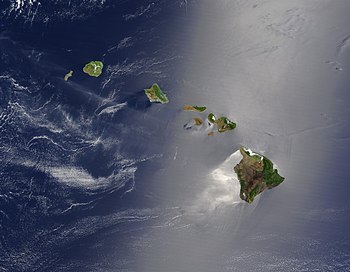Our website is made possible by displaying online advertisements to our visitors.
Please consider supporting us by disabling your ad blocker.
Portal:Islands
The Islands Portal
This is a list of the lists of islands in the world grouped by country, by continent, by body of water, and by other classifications. For rank-order lists, see the other lists of islands below. (Full article...)
Selected article –
Surtsey ("Surtr's island" in Icelandic, Icelandic pronunciation: [ˈsʏr̥(t)sˌeiː] ⓘ) is an uninhabited volcanic island located in the Vestmannaeyjar archipelago off the southern coast of Iceland. At Surtsey is the southernmost point of Iceland. It was formed in a volcanic eruption which began 130 metres (430 feet) below sea level, and reached the surface on 14 November 1963. The eruption lasted until 5 June 1967, when the island reached its maximum size of 2.7 km2 (1.0 sq mi). Since then, wave erosion has caused the island to steadily diminish in size: as of 2012[update], its surface area was 1.3 km2 (0.50 sq mi). The most recent survey (2007) shows the island's maximum elevation at 155 m (509 ft) above sea level.
The new island was named after Surtr, a fire jötunn or giant from Norse mythology. It was intensively studied by volcanologists during its eruption, and afterwards by botanists and other biologists as life forms gradually colonised the originally barren island. The undersea vents that produced Surtsey are part of the Vestmannaeyjar submarine volcanic system, part of the fissure of the sea floor called the Mid-Atlantic Ridge. Vestmannaeyjar also produced the famous eruption of Eldfell on the island of Heimaey in 1973. The eruption that created Surtsey also created a few other small islands along this volcanic chain, such as Jólnir and other, unnamed peaks. Most of these eroded away fairly quickly. It is estimated that Surtsey will remain above sea level until at least the year 2100. (Full article...)
Selected cuisines, dishes and foods –

Cuban cuisine is largely based on Spanish cuisine with influence from Taino, African and other Caribbean cuisines. Some Cuban recipes share spices and techniques with Spanish, Taino and African cooking, with some Caribbean influence in spice and flavor. This results in a blend of several different cultural influences. A small but noteworthy Chinese influence can also be accounted for, mainly in the Havana area. There is also some Italian influence. During colonial times, Cuba was an important port for trade, and the Spanish ancestors of Cubans brought with them the culinary traditions of different parts of Spain. (Full article...)
Related articles
- List articles
- List of islands
- List of islands by area
- List of islands by highest point
- List of islands by name
- List of islands by population
- List of islands by population density
- List of archipelagos
- List of archipelagos by number of islands
- List of artificial islands
- List of divided islands
- List of fictional islands
- List of island countries
- List of islands in lakes
- List of islands named after people
- List of islands of the European Union
- List of private islands
Selected image –

Did you know –

- ... that artificial islands were deployed in Hicklin Lake in an unsuccessful attempt to stop eutrophication?
- ... that CBS executive Laurence Tisch found out on a tennis court in the U.S. Virgin Islands that rival network NBC had bought his company's affiliate station in Miami?
- ... that the bridge on the R565 road to Valentia Island was opened twice?
- ... that future Georgia representative Edna Jackson was part of a wade-in to protest segregation at Tybee Island Beach?
- ... that one threatened species of plant endemic to the North Island of New Zealand is colloquially known as a forget-me-not?
- ... that the dispute between France and Mexico over Clipperton Island was settled by King Victor Emmanuel III of Italy?
General images –
Related portals
WikiProjects
Topics
Categories
Associated Wikimedia
The following Wikimedia Foundation sister projects provide more on this subject:
-
Commons
Free media repository -
Wikibooks
Free textbooks and manuals -
Wikidata
Free knowledge base -
Wikinews
Free-content news -
Wikiquote
Collection of quotations -
Wikisource
Free-content library -
Wikiversity
Free learning tools -
Wikivoyage
Free travel guide -
Wiktionary
Dictionary and thesaurus
Things to do
 |
Here are some tasks awaiting attention:
|
Web resources
- Listing of islands from the United Nations Island Directory
Previous Page Next Page
































































![Image 62The Shamanka Шаманка [ru], a holy rock in Shamanism and one of the 9 most holy places in Asia, on the westcoast of Olkhon (from List of islands of Russia)](http://upload.wikimedia.org/wikipedia/commons/thumb/2/27/Shaman_Kamen.jpg/120px-Shaman_Kamen.jpg)





































